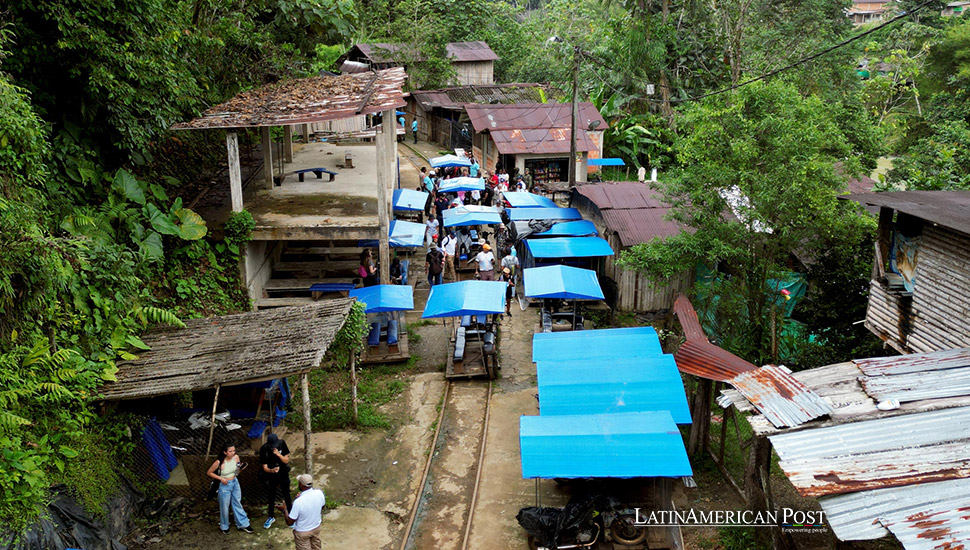Colombian ‘Brujitas’ Drive Ecotourism Success in San Cipriano’s Jungle

In the heart of Colombia’s jungle, the unique ‘brujitas’ transport tourists through old railway tracks to San Cipriano, a hidden gem for ecotourism. As EFE reports, this innovative system sustains the local economy and promotes environmental conservation.
From Cargo to Ecotourism
Along defunct railway tracks in western Colombia, an inventive and resourceful form of transportation has captivated both locals and tourists. The brujitas—wooden planks mounted on the tracks—offer a unique way to experience the lush beauty of Colombia’s jungle. These vehicles have become a beloved tourist attraction, originally designed to carry goods like bananas and household essentials. Visitors now ride the brujitas to the small community of San Cipriano, gaining access to one of the most biodiverse regions in Colombia.
The brujitas take passengers on a 20-minute journey between the town of Córdoba and San Cipriano, located in the department of Valle del Cauca. The route covers seven kilometers of jungle, allowing travelers to marvel at the vibrant flora and fauna of the region. Moving at speeds of up to 30 kilometers per hour, the leisurely pace creates an enchanting experience, almost as if one is gliding through a magical forest.
Lida Riascos, a member of one of the local cooperatives that manage the brujitas, highlighted their importance to the local economy. “The brujitas generate daily income for the transporters and the community,” she explained to EFE. The cooperative system provides employment and has transformed the once-isolated community into an ecotourism destination.
Initially, the brujitas were manually pushed by operators using poles, reminiscent of witches riding broomsticks, which gave rise to their name. Over time, as tourism increased, the brujitas were modernized into ‘motobrujitas,’ outfitted with benches and motorcycles to make the ride more comfortable and efficient. Introducing this motorized transport has made San Cipriano more accessible, boosting its profile as a must-see ecotourism spot in Colombia.
Ecotourism as a Lifeline for San Cipriano
Ecotourism has become a vital part of San Cipriano’s economy. The brujitas are the primary mode of transportation for tourists entering the area, providing a direct link between Córdoba and the San Cipriano Natural Reserve. Charging 18,000 pesos (around $4.20) for a round-trip ride, the transport offers visitors an exciting adventure through the jungle while also sustaining the community’s economy.
For the local population, the brujitas are more than a tourist attraction. They are daily lifelines residents use to travel to work, transport goods, and even ferry children to school. The unique transport system exemplifies how an innovative infrastructure approach can serve tourists and locals alike.
Cristian Sánchez, a long-time operator of the brujitas, shared his enthusiasm for the work. “It’s cool to provide this service because there are few job opportunities here,” he told EFE. For Sánchez and others, the brujitas represent more than just a means of transportation—they are a way to connect with tourists and share the natural beauty of their homeland, all while supporting their families.
San Cipriano’s key attractions, including the crystal-clear rivers and over 300 bird species, make it a paradise for nature lovers. The San Cipriano Natural Reserve is the crown jewel, offering an idyllic setting for birdwatching, swimming, and hiking. The growth of ecotourism has helped sustain the local economy, creating jobs and bringing much-needed resources into the community.
Conservation Efforts Powered by Community Cooperatives
The success of San Cipriano’s ecotourism industry is closely tied to the community’s commitment to conservation. The brujitas play a pivotal role in this effort, as they minimize environmental impact while allowing tourists to access the region’s most beautiful and fragile ecosystems. The local cooperatives, such as the one led by Lida Riascos, have been instrumental in ensuring that tourism in the area remains sustainable.
Riascos emphasizes that the cooperatives have provided a “light of hope” for the community and the surrounding environment. “They help protect the reserve, which benefits the nearby municipalities and Colombia as a whole,” she said. The cooperatives not only manage the brujitas but also work to maintain the delicate balance between tourism and conservation.
Through their efforts, the region’s natural beauty has been preserved, allowing visitors to enjoy an authentic experience in one of Colombia’s most pristine environments. The cooperatives ensure that the profits generated from tourism are reinvested into the community and conservation efforts, helping to protect the biodiversity that makes San Cipriano so special.
The region’s biodiversity is significant as Valle del Cauca prepares to host the COP16 Biodiversity Conference in October. This global event will bring experts and decision-makers to nearby Cali to discuss strategies for combating biodiversity loss. Valle del Cauca’s rich ecosystems, including the biogeographical Chocó, make it one of the most biodiverse areas in the country, showcasing the importance of protecting these environments for future generations.
Ecotourism and the Future of Valle del Cauca
As Valle del Cauca positions itself as a leader in ecotourism and conservation, local initiatives like the brujitas are helping to build a sustainable future for the region. The department’s diverse ecosystems, ranging from dense jungles to coastal habitats, offer many opportunities for ecotourism development. However, challenges remain, particularly in ensuring the safety of both locals and visitors as the region grapples with violence from armed groups.
Despite these challenges, local authorities and community leaders are optimistic about the future of ecotourism in Valle del Cauca. By adhering to safety recommendations and focusing on secure areas, tourists can experience the region’s magic while contributing to its economic growth. “Ninety percent of visitors leave with high satisfaction and a change in their mindset about the dangers,” said Julián Franco, Valle del Cauca’s Secretary of Tourism, in an interview with EFE.
Franco is enthusiastic about the potential of ecotourism to transform Valle del Cauca into a global destination. “The Valle is a hidden treasure, with spectacular biodiversity not only in nature but also in culture,” he said. He points to the brujitas as a prime example of how local communities can create unique, sustainable tourism experiences that benefit both the environment and the economy.
As the region prepares to welcome global experts for the COP16 Biodiversity Conference, Valle del Cauca’s approach to ecotourism offers a model for other areas of Colombia and beyond. By prioritizing conservation and empowering local communities, the region shows that tourism can be a powerful force for sustainable development.
Also read: Colombia’s Cultural Jazz Renaissance in Mompox
The brujitas of San Cipriano are more than just a quirky form of transportation—they represent the ingenuity and resilience of a community dedicated to preserving its natural surroundings while building a sustainable future. As EFE reports, these wooden planks-turned-tourist attractions have become a lifeline for the local economy, providing jobs, promoting conservation, and showcasing the beauty of Colombia’s jungle. With initiatives like this, Valle del Cauca is poised to become a leader in ecotourism, demonstrating how local innovation can drive global change in the fight to protect our planet’s biodiversity.





